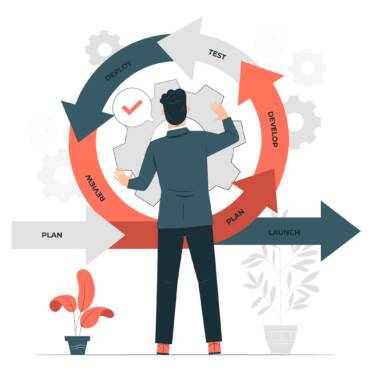Welcome to the world of data-driven advertising techniques! In today’s digital age, leveraging data is crucial for crafting effective campaigns. By utilizing data, you can create targeted ads, track key metrics, and refine your strategies. This blog will cover the fundamentals, essential metrics, implementation steps, and real-world success stories. Get ready to transform your advertising approach!
Understanding the Basics of Data-Driven Advertising Techniques

Advertising has come a long way from simple billboards and newspaper ads. Today, data-driven advertising techniques are revolutionizing the industry. But what exactly is data-driven advertising? Let’s break it down.
What is Data-Driven Advertising?
Data-driven advertising uses data analytics to guide your advertising strategies. Instead of relying on guesswork16, you use concrete data to make informed decisions. This approach helps you target your audience more accurately and measure the success of your campaigns.
Why is Data Important in Advertising?
Data is the backbone of modern advertising techniques. It provides insights into customer behavior, preferences, and demographics. When you know your audience, you can craft ads they love. This increases engagement and improves your return on investment (ROI).
Steps to Implement Data-Driven Advertising Techniques
You might wonder how to start with data-driven advertising techniques. First, collect data from various sources, like website analytics, social media metrics, and customer feedback. Then, analyze this data to identify patterns and trends. For instance, you might discover that your audience prefers video content over text-based ads.
Next, use these insights to craft targeted advertising campaigns. For example, if your data shows that young adults are your primary audience, design ads that appeal to their interests. Continuously monitor your campaigns and adjust them based on performance metrics.
Benefits of Data-Driven Advertising
One major benefit of data-driven advertising techniques is precision. You can target specific segments of your audience with personalized messages. This reduces wasted ad spend and increases the chances of conversion. Additionally, data helps you measure the effectiveness of your campaigns. You can track metrics like click-through rates, conversion rates, and customer acquisition costs.
Getting Started with Data-Driven Advertising
If you’re new to data-driven advertising techniques, start small. Use tools like Google Analytics to gather basic data about your website visitors. Social media platforms also offer valuable insights into user behavior. Gradually, incorporate more sophisticated analytics tools and techniques as you become comfortable with the process.
Key Metrics to Track for Effective Advertising

Tracking the right metrics is crucial for mastering advertising techniques. These metrics provide insights into your campaign’s performance and help you make data-driven decisions. Let’s dive into the key metrics you should focus on.
Click-Through Rate (CTR)
The Click-Through Rate (CTR) measures how often people click on your ads after seeing them. A high CTR indicates that your ad is engaging and relevant to your audience. To calculate CTR, divide the number of clicks by the number of impressions and multiply by 100. For example, if your ad had 1,000 impressions and 100 clicks, your CTR would be 10%.
Conversion Rate
Conversion rate is one of the most important metrics in advertising techniques. It measures the percentage of users who take a desired action after clicking on your ad. This action could be making a purchase, signing up for a newsletter, or downloading a resource. To calculate conversion rate, divide the number of conversions by the number of clicks and multiply by 100. A high conversion rate means your ad and landing page are effectively driving user actions.
Cost Per Click (CPC)
Cost Per Click (CPC) indicates how much you pay each time someone clicks on your ad. It’s essential to monitor CPC to ensure you’re getting the most out of your advertising budget. To lower your CPC, focus on improving ad quality and relevance. This can lead to better ad placements and lower costs.
Return on Ad Spend (ROAS)
Return on Ad Spend (ROAS) measures the revenue generated for every dollar spent on advertising. To calculate ROAS, divide your total revenue by your total ad spend. For example, if you made $500 from an ad campaign that cost $100, your ROAS would be 5. A high ROAS means your advertising techniques are paying off.
Bounce Rate
Bounce rate tracks the proportion of visitors who leave your website after viewing just one page. A high bounce rate may suggest that your landing page is not relevant or engaging. To reduce bounce rate, ensure your landing page matches the ad’s message and provides a clear call-to-action.
Impressions and Reach
Impressions represent the number of times your ad is shown, while reach refers to the number of unique users who see your ad. These metrics help you understand the scope and visibility of your campaign. High impressions and reach can increase brand awareness and drive more traffic to your site.
How to Implement Data-Driven Advertising Strategies

Implementing data-driven advertising strategies can seem daunting, but it’s simpler than you might think. With the right approach, you can leverage data to boost your campaigns and see real results.
Start with Clear Goals
Before diving into data, you need clear goals. What do you want to achieve with your advertising techniques? Whether your goal is to attract website traffic, enhance brand awareness, or increase sales, setting specific objectives will direct your strategy effectively. Clear goals help you focus on the right data and make informed decisions.
Collect and Analyze Data
Next, gather data from various sources. Use tools like Google Analytics to track website activity and social media analytics to understand audience behavior. Customer surveys and feedback can also provide valuable insights. After gathering the data, analyze it to uncover trends and patterns. Look for metrics that align with your goals, such as high-performing content or peak engagement times.
Segment Your Audience
Audience segmentation is a key part of data-driven advertising techniques. By dividing your audience into smaller groups based on demographics, interests, or behaviors, you can create more personalized ads. For example, if you notice a segment of your audience prefers video content, tailor your ads to include more videos for that group. This guarantees your message connects with the right audience.
Craft Targeted Campaigns
Now that you understand your audience better, it’s time to craft targeted campaigns. Use the insights from your data analysis to create ads that appeal to each segment. Personalization is crucial here. Personalized ads are more likely to catch your audience’s attention and drive engagement. Experiment with various ad formats, messages, and visuals to determine what performs best.
Monitor and Adjust
Implementing data-driven advertising techniques is an ongoing process. Continuously monitor your campaigns to see how they’re performing. Utilize metrics such as conversion rates, click-through rates, and return on ad spend to measure success. Feel free to adjust your strategy if something isn’t effective. Data-driven advertising allows you to be flexible and responsive to changes.
Automate Your Advertising with These Tools
Automation tools can streamline your data-driven advertising efforts. Platforms like Google Ads and Facebook Ads Manager offer automated bidding, audience targeting, and performance tracking. These tools save time and ensure your campaigns are optimized for the best results.
Real-World Examples of Successful Use of Data-Driven Advertising Techniques

Understanding successful data-driven advertising campaigns can inspire your efforts. Let’s explore some real-world examples where brands used data to achieve impressive results.
Coca-Cola’s Personalized Bottles
Coca-Cola’s “Share a Coke” campaign is a classic example of effective advertising techniques. By replacing their iconic logo with popular names on bottles, Coca-Cola created a personalized experience for consumers. This campaign was data-driven because it relied on extensive research about popular names in different regions. As a result, it boosted sales and engagement globally. You could apply similar personalization tactics in your campaigns.
Netflix’s Recommendation Engine
Netflix excels in using data to drive its advertising techniques. They analyze viewing habits to recommend shows and movies tailored to each user. This type of personalization maintains user engagement and significantly reduces churn. By leveraging data, Netflix ensures that its advertising resonates with individual preferences. Think about using data to tailor your ads to your audience’s interests.
Spotify’s Wrapped Campaign
Spotify’s annual “Wrapped” campaign is another brilliant example. They provide users with personalized year-in-review playlists based on their listening data. This campaign is not only engaging but also highly shareable. Users love seeing their listening stats and sharing them on social media. You can draw inspiration from this by creating shareable, personalized content for your audience.
Amazon’s Product Recommendations
Amazon’s recommendation system drives significant sales through data-driven advertising techniques. They use browsing and purchase history to suggest products to users. This tailored approach boosts the chances of repeat purchases. By understanding customer behavior, Amazon keeps shoppers engaged and boosts sales. Consider how you can use data to recommend products or services to your customers.
Conclusion
Data-driven advertising techniques are transforming brand-audience connections. By understanding the basics of data-driven advertising techniques, you can optimize your efforts. Embrace these techniques to improve ROI and achieve lasting success. Start your data-driven advertising journey today and watch your brand soar!
For more expert insights and customized advertising solutions, contact Friends Media today!


